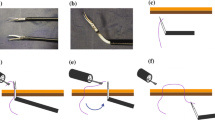Abstract
Background
The indications for natural orifice translumenal surgery (NOTES) are yet to be determined. Morbidly obese patients may be one population that would benefit from this approach due to the elimination of wound complications and possibly a faster recovery. As a bariatric restrictive procedure, sleeve gastrectomy could be one indication for NOTES. To test the feasibility of this procedure with a NOTES approach, a pig model was used.
Methods
Acute studies investigated five 40-kg farm pigs. The rectum was used as the port of entry to the peritoneal cavity, and the stomach was manipulated endoluminally using a gastroscope. Vision was acquired through a 5-mm laparoscope introduced transabdominally (i.e. via the hybrid technique). A 10-mm incision was made on the anterior wall of the rectum and dilated to accommodate a 12-mm trocar introduced through the rectal wall into the peritoneal cavity. The greater curvature of the stomach then was divided and detached, starting from the antrum and proceeding to the esophagogastric junction using a laparoscopic stapler. The sleeve gastrectomy was completed by dividing the short gastric vessels with an ultrasonic scalpel. The gastric pouch then was removed through the rectal incision.
Results
A NOTES gastric sleeve resection was successfully performed in all five pigs. The technique was developed, and feasibility was determined. After resection, the gastric remnant was inflated, with no evidence of leakage. At autopsy, intact suture lines were noted. Closure of the rectal incision was not attempted.
Conclusion
A NOTES sleeve gastrectomy is feasible in porcine animal models. The rectal port of entry allows rigid laparoscopic instruments to be introduced into the peritoneal cavity and enables performance of gastrointestinal procedures the same as in standard laparoscopic surgery. Extra-long instruments are necessary for dissection and division of the stomach at the esophagogastric junction and for accessing the short gastric vessels.



Similar content being viewed by others
References
Kalloo AN, Singh VK, Jagannath SB, Niiyama H, Hill SL, Vaughn CA, Magee CA, Kantsevoy SV (2004) Flexible transgastric peritoneoscopy: a novel approach to diagnostic and therapeutic interventions in the peritoneal cavity. Gastrointest Endosc 60:114–117
Pai RD, Fong DG, Bundga ME, Odze RD, Rattner DW, Thompson CC (2006) Transcolonic endoscopic cholecystectomy: a NOTES survival study in a porcine model (with video). Gastrointest Endosc 64:428–434
Park PO, Bergstrom M, Ikeda K, Fritscher-Ravens A, Swain P (2005) Experimental studies of transgastric gallbladder surgery: cholecystectomy and cholecystogastric anastomosis (videos). Gastrointest Endosc 61:601–606
Jagannath SB, Kantsevoy SV, Vaughn CA, Chung SS, Cotton PB, Gostout CJ, Hawes RH, Pasricha PJ, Scorpio DG, Magee CA, Pipitone LJ, Kalloo AN (2005) Peroral transgastric endoscopic ligation of fallopian tubes with long-term survival in a porcine model. Gastrointest Endosc 61:449–453
Wagh MS, Merrifield BF, Thompson CC (2006) Survival studies after endoscopic transgastric oophorectomy and tubectomy in a porcine model. Gastrointest Endosc 63:473–478
Merrifield BF, Wagh MS, Thompson CC (2006) Peroral transgastric organ resection: a feasibility study in pigs. Gastrointest Endosc 63:693–697
Bergstrom M, Ikeda K, Swain P, Park PO (2006) Transgastric anastomosis by using flexible endoscopy in a porcine model (with video). Gastrointest Endosc 63:307–312
Kantsevoy SV, Jagannath SB, Niiyama H, Chung SS, Cotton PB, Gostout CJ, Hawes RH, Pasricha PJ, Magee CA, Vaughn CA et al (2005) Endoscopic gastrojejunostomy with survival in a porcine model. Gastrointest Endosc 62:287–292
Kingsnorth A (2006) The management of incisional hernia. Ann R Coll Surg Engl 88:252–260
Arribas D, Elia M, Artigas C, Jimenez A, Aguilella V, Martinez M (2004) Incidence of incisional hernia following vertical banded gastroplasty. Hernia 8:135–137
Uslu HY, Erkek AB, Cakmak A, Kepenekci I, Sozener U, Kocaay FA, Turkcapar AG, Kuterdem E (2007) Trocar-site hernia after laparoscopic cholecystectomy. J Laparoendosc Adv Surg Tech A 17:600–603
Bowrey DJ, Blom D, Crookes PF, Bremner CG, Johansson JL, Lord RV, Hagen JA, DeMeester SR, DeMeester TR, Peters JH (2001) Risk factors and the prevalence of trocar-site herniation after laparoscopic fundoplication. Surg Endosc 15:663–666
Shaher Z (2007) Port-closure techniques. Surg Endosc 21:1264–1274
Mintz Y, Horgan S, Cullen J, Ramamoorthy S, Chock A, Savu MK, Easter DW, Talamini MA (2007) NOTES: the hybrid technique. J Laparoendosc Adv Surg Tech A 17:402–406
Edwards MA, Jones DB, Ellsmere J, Grinbaum R, Schneider BE (2007) Anastomotic leak following antecolic versus retrocolic laparoscopic Roux-en-Y gastric bypass for morbid obesity. Obes Surg 17:292–297
Hamilton EC, Sims TL, Hamilton TT, Mullican MA, Jones DB, Provost DA (2003) Clinical predictors of leak after laparoscopic Roux-en-Y gastric bypass for morbid obesity. Surg Endosc 17:679–684
Marshall JS, Srivastava A, Gupta SK, Rossi TR, DeBord JR (2003) Roux-en-Y gastric bypass leak complications. Arch Surg 138:520–523; discussion 523–524
Lalor PF, Tucker ON, Szomstein S, Rosenthal RJ (2008) Complications after laparoscopic sleeve gastrectomy. Surg Obes Relat Dis 4:33–38
Galvani C, Gorodner M, Moser F, Baptista M, Chretien C, Berger R, Horgan S (2006) Laparoscopic adjustable gastric band versus laparoscopic Roux-en-Y gastric bypass: ends justify the means? Surg Endosc 20:934–941
Author information
Authors and Affiliations
Corresponding author
Rights and permissions
About this article
Cite this article
Mintz, Y., Horgan, S., Savu, M.K. et al. Hybrid natural orifice translumenal surgery (NOTES) sleeve gastrectomy: a feasibility study using an animal model. Surg Endosc 22, 1798–1802 (2008). https://doi.org/10.1007/s00464-008-9915-y
Received:
Revised:
Accepted:
Published:
Issue Date:
DOI: https://doi.org/10.1007/s00464-008-9915-y




